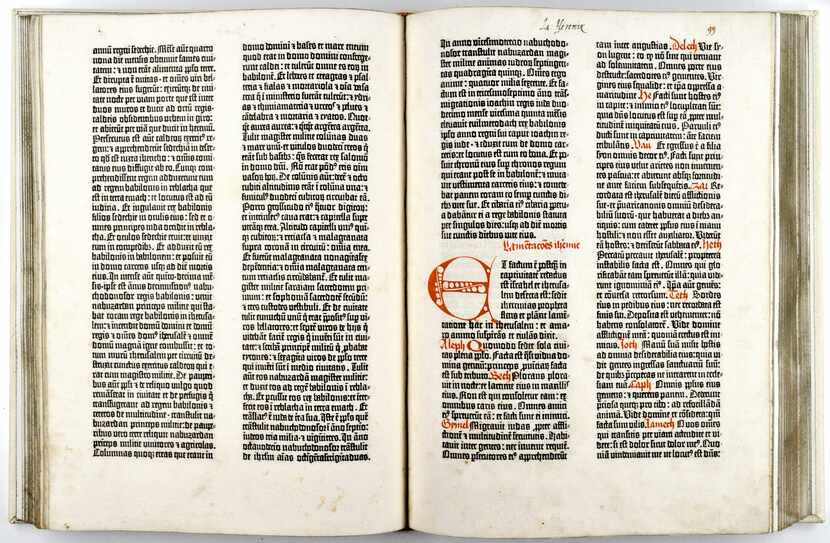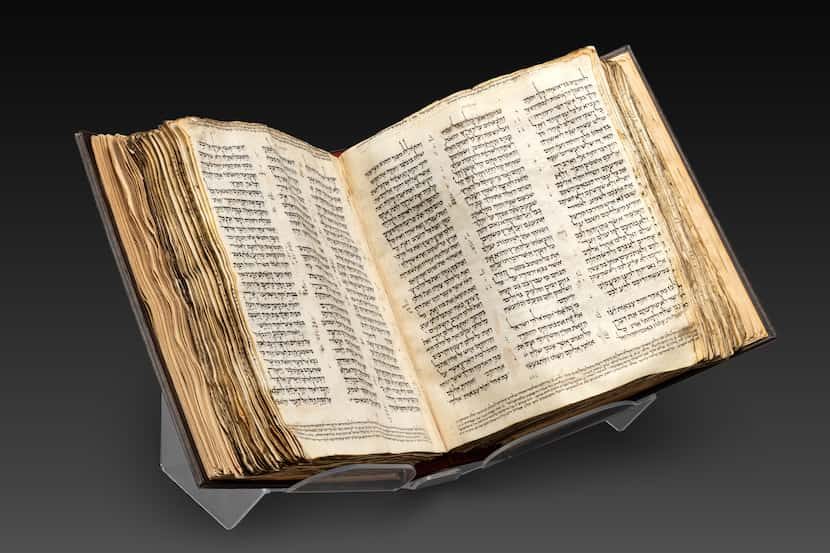The earliest and most complete Hebrew Bible, which could become the most expensive historical document when auctioned next month in New York, is making a stop April 18-20 at Southern Methodist University’s Bridwell Library, in between showings in London, Tel Aviv and Los Angeles.
Known as the Codex Sassoon after its most illustrious owner, David Sassoon, the 10th-century book’s great value can be ascribed to its distinctive position in the millennia-long tradition that gave us the Hebrew Bible found in bookstores today (also known by Christians as the Old Testament).
The overall integrity of this tradition is evident in, for example, the Book of Isaiah, one of the 24 books that make up the Hebrew Bible. This book is recognizably the same in the 2,100-year-old Great Isaiah Scroll found in the Qumran Caves of the Judaean Desert, the 1,100-year-old Codex Sassoon and a modern published edition.
“Because there is so much that is identical between what we find in some of the Dead Sea Scrolls and later texts, like Codex Sassoon, it is clear that little, if anything, was lost,” says Roy Heller, professor of Old Testament at SMU.
With the zeal of modern data engineers who see that not a bit of memory goes out of place each time a computer document is duplicated, countless generations of Jewish scribes dedicated themselves to ensuring that generation after generation, each copy was the same as the last, as far as humanly possible.
The Codex Sassoon, however, represents a key advance in recording technology: While the ancient Hebrew Bible was written using consonants only, medieval scribes known as the Masoretes developed for the first time a set of dot marks for vowels (niqqud) and thus indicated a correct pronunciation for the text.
Even without reading Hebrew, viewers of the codex will be able to notice the small, delicate and precise dots and dashes of the niqqud, which appear together with other notes on the text that are collectively known as the Masorah. These other notes include “alternative spellings, other places where particular words occur in the Bible, notations that a word only appears at that point in the whole Bible, etc., and show the intense care and knowledge that the scribes, the Masoretes, had for this text,” Heller explains.

Out of the hundreds of manuscripts the Masoretes produced, only six have survived to the present. While five of those are in institutional collections, the Codex Sassoon is the only one left in private hands and thus ever likely to come up for sale.
The book’s scale gives an immediate sense of its value — 6 inches thick and 25 pounds, written on about 400 pages of sheepskin parchment generously donated by 100 or so animals. Only 12 of its pages are missing. By contrast, the most authoritative Masoretic manuscript, the Aleppo Codex or the “Crown of Aleppo,” completed by the pre-eminent Masorete Aaron ben Moses ben Asher, is missing over a third of its original 487 pages.
“The Sassoon Codex is immensely important,” says Nehemia Gordon, executive director of the Institute of Hebrew Bible Manuscript Research and one of the very few scholars to study the codex in person since 1989.
Gordon and his colleagues believe that a later 12th-century inventory reference to “the brother of the Crown” refers to the Codex Sassoon and shows its importance. A note on page 112 of the Codex Sassoon, he points out, refers to “the work of the great teacher Aaron ben Asher” and “the codex known as the Crown,” emphasizing the close connection between the two codices.
Carbon-dated to the 10th century, the codex has spent most of its life out of the public eye. After its home synagogue in Syria was sacked by medieval Mongol or Timurid invaders, the Codex Sassoon vanished from public view for six centuries, before being acquired in 1929 for £350 by David Sassoon, a major collector of Hebraica who gave it pride of place in his collection of over 1,000 manuscripts and artifacts.
The connection with the Sassoons, an illustrious Baghdad-based Jewish merchant family known as the “Rothschilds of the East” and the subject of a recent book and current New York exhibition, adds luster to the codex’s history.
Since it entered David Sassoon’s collection, it has been sold twice more, once in 1978 by his heirs to the British Rail Pension Fund for $320,000 and then in 1989 for $4.16 million to the present seller, Jacqui Safra, a Geneva investor and descendant of another renowned Middle Eastern Jewish family. Before the current tour, it was publicly exhibited only once, in 1982 at the British Museum. At the upcoming auction, it may become the most expensive historical document ever sold, eclipsing the current record of $43 million for a first printing of the U.S. Constitution.
The show also provides a good excuse to admire some of the treasures in the Bridwell’s first-rate collection of rare books and manuscripts, including a Gutenberg Bible and a sixth-century papyrus manuscript of the Book of Romans. At a time when many libraries are being taken over by electronic screens, feeling the solemnity and longevity of these great books is a special experience.

Details
The Codex Sassoon will be on view at Bridwell Library, SMU, 6005 Bishop Blvd., on Tuesday, April 18, from 9 a.m. to 6 p.m., Wednesday, April 19, from 9 a.m. to 9 p.m., and Thursday, April 20, from 9 a.m. to 9 p.m. Free entry; timed ticket required. info.smu.edu/codex-sassoon. For more information, email codexinfo@smu.edu.


/cloudfront-us-east-1.images.arcpublishing.com/dmn/ZFJWX63LQRF42Q2PTATHP6RPQY.jpg)
/cloudfront-us-east-1.images.arcpublishing.com/dmn/7PJ7Y4VIDYIS32CXXLS7CT77Z4.jpg)
/cloudfront-us-east-1.images.arcpublishing.com/dmn/CFAA2WNNANBFDLACCGGYNX5ORY.jpg)
/cloudfront-us-east-1.images.arcpublishing.com/dmn/BNVJWBKVZ5GMTJ6WQRIUYBD2H4.jpg)
/cloudfront-us-east-1.images.arcpublishing.com/dmn/LAAQBB3ASBETJKMCZA4XDW3DS4.jpg)